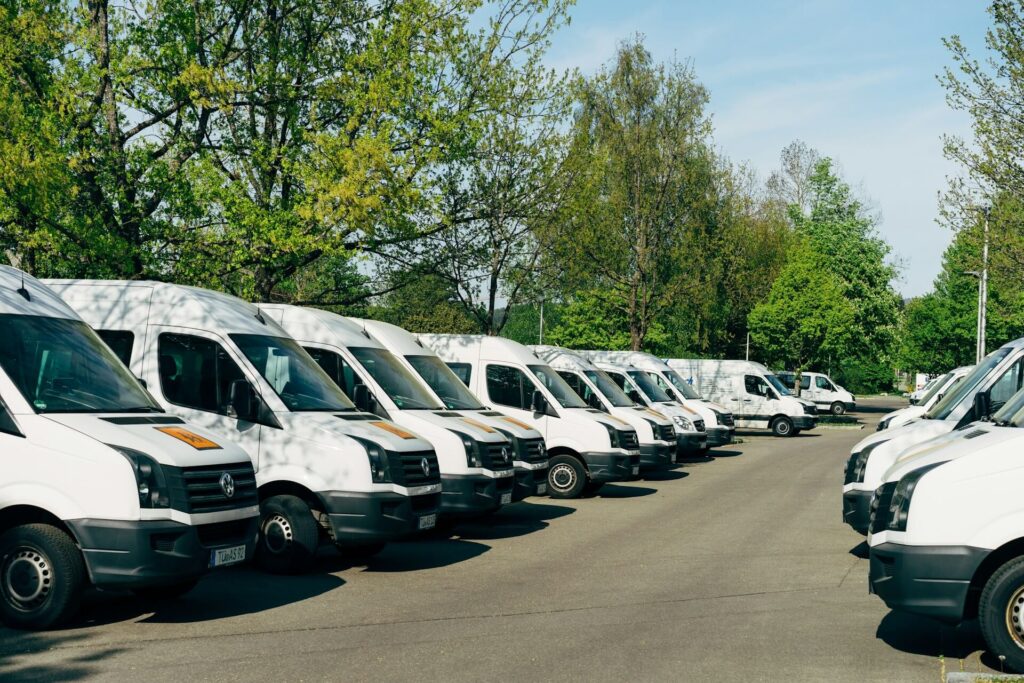What is Fleet Safety?
Fleet safety is the promotion and creation of safety guidelines within transportation organizations. The goal of fleet safety is to reduce and prevent accidents that negatively affect both employees and the employer.
Fleet safety involves every task performed to keep a company’s fleet running efficiently, within budget, on time, and safely.
Outside of protecting people, fleet safety and fleet management also impacts a business’ reputation, bottom line, and acquisition capabilities. For example, if a company is known to have a high volume of fleet accidents, then they will be less likely to attract drivers. Additionally, proper fleet management and safety results in lower equipment and vehicle costs.

Understanding Risks to Fleet Safety
There are many challenges and threats to the safety of a fleet. In an effort to minimize accidents, it’s recommended for organizations to focus on:
Driver Safety
Distracted drivers are a major threat to safety, as you know. There are several fleet safety solutions that can be implemented to reduce this risk entirely. For example, it’s optimal for employees to keep their hands on the wheel and eyes on the road. But, if they have to alert a team member or dispatch of an issue, they may feel inclined to pick up their device and text or look down at a paper-based checklist. Instead, they can leverage speech AI technology like aiOla to run through checklists and collaborate seamlessly with nothing other than their voice.
Training Programs
Driver training programs can help to identify behaviors that threaten driver safety and lessen them.
Fuel Efficiency
The cost of fuel is continuing to rise. Vehicle telematics can be used to optimize routes and minimize fuel consumption as a result. While minimizing fuel expenditure, you also can minimize the time spent on the road, which further lowers the risk of accidents.
Vehicle Maintenance
Proper vehicle maintenance protects the vehicle and its driver. Fleet technology should be implemented to monitor fuel usage, tire pressure and more in real-time, promoting adequate upkeep and enabling vehicles to remain on schedule. Many organizations spend hours a day conducting maintenance checklists before allowing a truck to hit the road. This inefficiency results in lost opportunities and inhibits revenue maximization. Here’s another example of where aiOla can be used. Take a look at how aiOla helped to cut a Fortune 100’s fleet inspection time from 15 minutes per vehicle to only 60 seconds (a 85% time savings)!
Legal and Regulatory Compliance
With the many threats to fleets and their safety, we haven’t yet touched on fleet compliance. Fleet compliance ensures that organizations adhere to the standards set by the Federal Motor Carrier Safety Administration (FMCSA) and the Department of Transportation (DOT).
These regulations oversee any commercial vehicle that moves passengers or cargo in interstate commerce. For compliance, fleets must maintain updated records and perform inspection requirements. When inspections are performed, issues must be addressed and remedies before a vehicle can get back on the road. Plus, preventative and continuous maintenance schedules are a must.
Technology’s Role in Fleet Safety
The good news is that with all the spinning wheels of fleet safety, there are technologies ready to assist. Technology has played a major role in being able to improve fleet safety.
Fleet management software stores inspection data and makes it accessible. It also connects telematics devices and GPS and driver behavior updates for better internal control. Better visibility helps to stay on track with compliance, maintenance, and approval processes.
These advanced safety solutions and tools are even stronger when fleet drivers, mechanics, and managers are able to execute their day-to-day responsibilities hands-free and with utmost safety. Speech-enabled technology delivers this unparalleled ability. Not only does aiOla help critical employees complete crucial tasks, but it also captures otherwise unstructured and lost data that occurs in speech. By capturing this information, people within the organization gain insights into patterns and can leverage the data to forecast impending issues or maintenance concerns before they come to light. A proactive approach to fleet safety can literally save lives.
How to Evaluate Fleet Safety
There are different fleet management key performance indicators (KPIs) that you can track to oversee performance and strive for perfection. Every business will prioritize different metrics, but here are a few key components to keep an eye on:
- Fuel consumption: Idling time is useful to measure because it affects miles per gallon (MPG)
- Fleet productivity: average monthly mileage, average load size, and average number of deliveries per week
- Vehicle failures: downtime or unexpected maintenance affects your ability to best service customers. It’s a good idea to have a contingency plan in the event of a vehicle breakdown.
Fleet safety: Automatic accident log recordings, telematics cameras for spot-checks and advanced driver assistance (ADAS) features.

Best Practices in Fleet Safety
Every organization wants to optimize the safety of their vehicles and employees. Here are some recommendations and best practices to do so:
Have a Fleet Safety Policy
A fleet safety policy can make a big difference by defining in detail rules and responsibilities of everyone involved within a fleet. For example, areas of importance worth documenting a plan for include: night driving, resting intervals, and fatigued driving, to name a few.
Invest in Technology
Leverage fleet safety solutions and technology that exist to help! From fleet management software to automation tools to AI-powered speech technology, it’s always best to keep your drivers focused on a single mission – the road and reaching their destination.
Optimize Routes and Minimize Road Risks
Weather and road conditions can affect a fleet operator’s ability to perform at their fullest potential. For example, driving long distances or having the wrong vehicles for the conditions pose threats. Fleet managers should take all the variables into consideration when they are creating a fleet safety plan and schedule.
The Journey of Fleet Safety Doesn’t Have a Final Destination
Fleet safety and management is ever evolving and continuous. From a business’ perspective, proper handling of your employees, vehicles, and deliveries will result in a better bottom line, less risk, compliance adherence, and satisfied customers. It’s in everyone’s best interest to truly prioritize fleet safety, and there’s no excuse for allowing fleet safety to remain overlooked.


